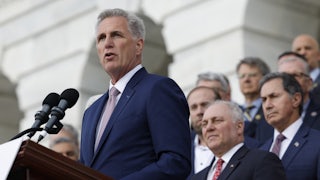Remember when House Speaker Kevin McCarthy was going to force cuts in Pentagon spending? McCarthy, it appears, does not.
At the start of 2023, we were advised that this was not our father’s Republican Party. “Congress needs to put away its kid gloves,” wrote Kevin Roberts, president of the conservative Heritage Foundation, “and put the Department of Defense and other agencies alike under the knife to excise wasteful spending.” Congressional Republicans, Roberts wrote, were ready to do it. The Freedom Caucus demanded, as a condition of allowing McCarthy to become speaker, a freeze on discretionary spending to its level in fiscal year 2022, which ended September 30. Because no exception was made for defense, that meant a $75 billion cut in Pentagon spending.
The Republican position was seen, among other things, as a vote of no confidence in U.S. aid to Ukraine, given that $75 billion was about what the United States sent to Ukraine over the previous calendar year. “We’ll find some initial cuts in the Pentagon,” said Representative Ken Calvert of California, incoming chair of the House defense appropriations subcommittee, in an interview with Defense News. These would be “throughout the Department of Defense” and would “not hurt capability.”
Appearing January 15 on Fox News, McCarthy was asked whether he’d promised the Freedom Caucus that he’d go back to 2020 spending levels on defense (see 12:20). “That was what we were spending just two, three weeks ago,” McCarthy protested. (Actually, it was closer to 14 weeks, but who’s counting.) “That’s not cutting defense by $75 billion.” What McCarthy meant was that most of the $75 billion in defense spending allocated through September 30, 2024, had not yet been spent, and so, if withdrawn, would not be missed. He continued:
Does defense [get] more than $800 billion, are there areas that I think they could be more efficient in? Yeah. Eliminate all the money spent on woke-ism. Eliminate all the money that they’re trying to find different fuels, and they’re worried about the environment, to go through.… I’m sure they could find some places that they could be more efficient.
At the time, I wondered where McCarthy got the idea that you could save $75 billion (more recently, the Pentagon estimated the necessary cuts at $73.7 billion) simply by eliminating the Defense Department’s “woke” budget. I calculated that budget to be about $5 million. Perhaps my estimate was too low, but even Heritage’s Roberts, who, like McCarthy, reviles “wokeness and waste” in defense spending, citing in his essay vaccine requirements and diversity training, could find no more than $1.4 billion in wokery to cut before he slammed down his meat cleaver on weapons systems and military bases. Was McCarthy really going to make his price for raising the debt ceiling lower spending on military hardware and facilities?
Of course not.
When McCarthy finally made public the text of his debt-ceiling bill, it reduced on paper all discretionary spending, including defense spending, to 2022 levels. But it wasn’t reported that way because everybody knew there was already broad agreement among House Republicans that the Defense Department’s share of the cuts would be reassigned to other areas of domestic spending. Yet even with that built-in assumption, McCarthy doesn’t appear to have the necessary 118 Republican votes to pass the bill (which in any case would be dead on arrival in the Democratic-controlled Senate). So McCarthy’s “Limit, Save Grow Act of 2023” could turn out to be no more than a grandiose bluff.
And yet the question persists: Where is that $75 billion that fits McCarthy’s definition of woke military spending? I submit that it resides within the Veterans Administration.
The VA has a total budget of $308.5 billion, of which about $140 billion is discretionary and therefore subject to McCarthy’s cuts. The VA is not part of the defense budget, so it’s a fudge to call it military spending, but in a way that’s the point. Heritage’s Roberts wrote that “Congress should insist that every dollar is used to advance military lethality and readiness while saving taxpayers as much as possible.” Spending on veterans, who by definition already completed their military service, does absolutely nothing to advance military lethality and readiness. Ergo, it’s all wokeness and waste.
McCarthy would never say this, of course, or perhaps even think it. But have you ever really thought about the VA? It’s the only Cabinet department that addresses needs and grievances on the basis of group identity. Yes, we have an Agriculture Department, but that isn’t really the Department of Farmers; as Michael Lewis has observed, at this late date “most of what it does has little to do with agriculture.” Yes, we have a Labor Department to address the needs and grievances of laborers, but in our not-even-close-to-socialist country, being a worker doesn’t slot you into any recognized group identity. (Sorry, comrade.) And yet, when you fill out a job application, what do they ask you? Whether you’re African American or Hispanic or Asian/Pacific Islander or Native American or … a “former member of the armed services.”
The VA fits precisely the conservative definition of a woke institution where members of certain favored groups are encouraged to boo-hoo for special favors. The non-conservative and morally defensible definition of the VA is that it provides social services and medical care to former members of the military in gratitude for their service and in recognition of any special needs created by the extraordinary sacrifices they may have been asked to make for their country. This is the definition even the severest conservative critic of wokeness will profess.
Yet as various news stories this past week in the military press reported, and as the Biden White House was quick to emphasize, McCarthy’s war on government waste would slash spending on veterans. Economists call this “revealed preference.”
Back in January, Representative Rosa DeLauro, ranking member of the House Appropriations Committee, asked all federal agencies to report to her the likely consequences of the return to fiscal year 2022 spending levels that McCarthy was already advocating. The replies, received in March, all merit your attention, but that of Veterans Affairs Administrator Denis McDonough is especially piquant. McDonough wrote that if the Pentagon made cuts just like the other agencies, then the VA would have to cut $26.7 billion from its discretionary budget (out of a total of about $140 billion). If the Pentagon didn’t have to make cuts, McDonough wrote, then the VA would have to cut $29.7 billion. “Both scenarios are unacceptable,” McDonough wrote, “and would dramatically impact medical care accounts and limit our ability to deliver the care and benefits that veterans have earned and deserve.”
McDonough cited as an example that part of VA’s appropriation that funds the processing of benefit claims. If its appropriation were frozen at the 2022 level, he wrote, then the VA would be compelled to lay off 1,178 members of the staff performing this function and to delay “automation and optimization” in the processing of benefits, with the result that “the backlog of claims would grow.” McDonough might have added (but didn’t): “When angry veterans complain, we’ll be glad to explain why it’s the House Republicans’ fault.” A VA release this past week further elaborated how McCarthy’s bill would hurt veterans.
Perhaps House Republicans will in the end address their VA problem by exempting both the Defense Department and the VA from their debt-ceiling bill’s spending caps. But if they do that and maintain their commitment to returning to 2022 spending levels, that will further expand the necessary cuts to other agencies. As it is, calculations by the nonprofit Center on Budget and Policy Priorities estimate that sparing Defense would increase the necessary cuts to other agencies to 27 percent. Sparing veterans would boost that percentage still higher.
The VA is a vivid illustration of what domestic discretionary spending really is, as opposed to what conservatives pretend it is. Twenty years ago, support to veterans cost the federal government about $50 billion annually. Today it costs the federal government more than $250 billion, and that doesn’t include the cost of running the Cabinet agency that writes the checks. That may sound like runaway spending, but the increase isn’t because of waste, fraud, and abuse. It’s because we fought wars in Afghanistan and Iraq that imposed large societal costs, and because veterans of earlier wars in Vietnam, Korea, Germany, and Japan are now elderly and vulnerable.
There’s no magic solution here, any more than there’s a magic way to cut other discretionary spending without inflicting pain. Yes, there’s a little waste here and there, but not a lot. If you want to restore solvency to federal spending, you have to raise taxes, cut defense spending, and perhaps trim some entitlement spending. Mostly you have to raise taxes, something not even Democrats are ready to recognize in full. Pretending otherwise becomes very dangerous when made a condition of raising the debt limit. It may take a genuine market panic for McCarthy to stop playing games with the creditworthiness of the U.S., and there’s no guarantee even that would be enough.






